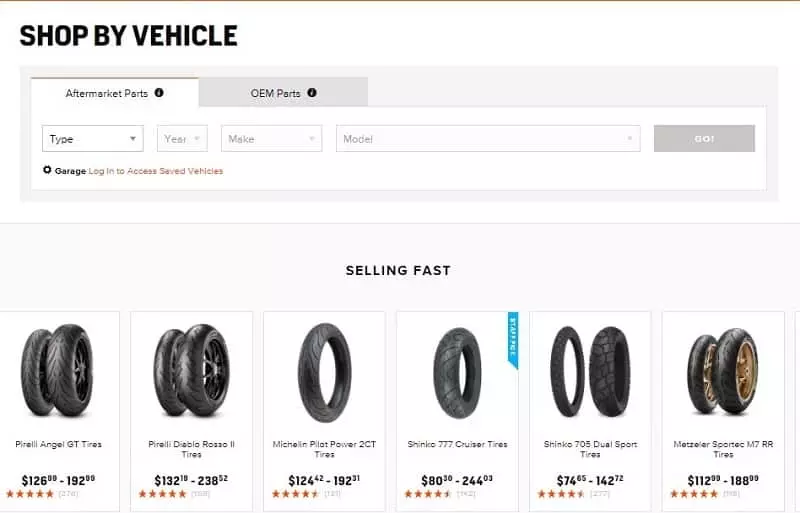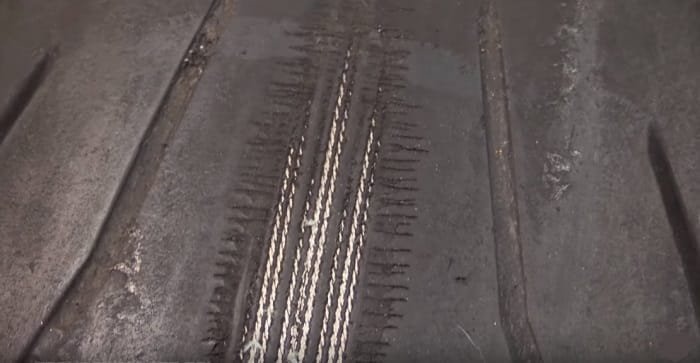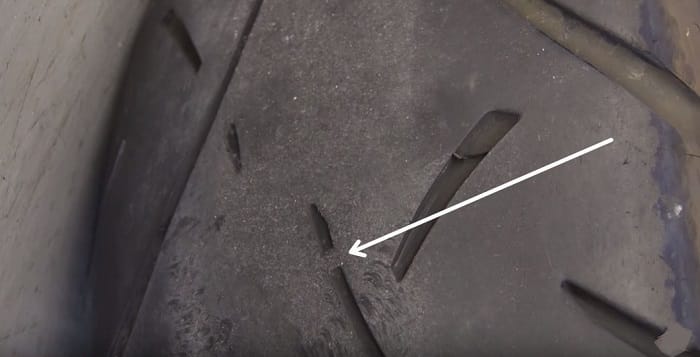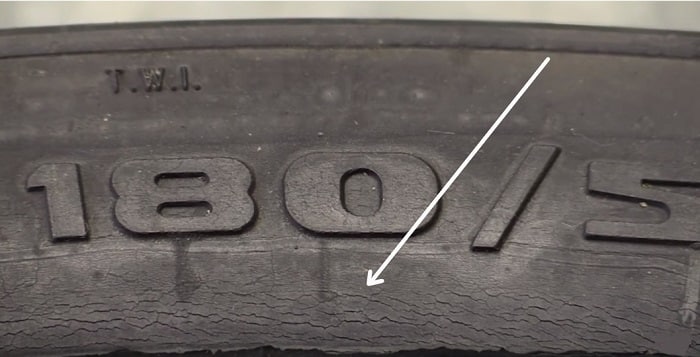It doesn’t matter if you are riding a cruiser, a Harley, or just touring; everything that has ever been manufactured has an expiry date, and motorcycle tires are no different.
How do you know when to change motorcycle tires? A motorcycle’s front tires can be viable for up to 3900 miles, and the rear tires for 1,900 miles, or three to five years.
For the best prices on any motorcycle tire visit revzilla.com

Tires are one of the most critical components keeping us from landing on our heads. Many factors contribute to a tire being worn out, including the most obvious. This is an extreme example of a tire being flat worn out.
This is what we jokingly refer to as “throwing sparks.” The rubber has worn away revealing the metal bands, or chords, that hold the tire together.
When the rubber starts making these weird patterns, that means the metal chords are just about to wear through.

It’s worth noting that a tire does not wear at the same rate throughout its life. As the rubber becomes thinner, the tire wears faster. Like car tires, motorcycle tires have wear bars.
When the tire wears down to the point where these bars are level with the rest of the tire, it’s time to replace it.

For most modern motorcycle tires, the front tire is tasked with moving all the water out of the way.
This often means the rear tire will have a solid strip of rubber with no saiping or tread in the center.
This is done to help the rear tire wear more slowly and withstand more abuse from acceleration.
This is why it’s essential to always run matched tires. Not only can mismatched tire construction cause we’re handling issues, but the tread pattern on matching tires has been specifically engineered to work together.
The problem with tires with this solid strip of rubber in the center is that it’s tough to tell when the tire is at the end of its life, particularly for those of us who live in and ride in the real world, where we wear out tires in the center long before we wear them out at the edges.
So here’s our plea to the manufacturers. Race slicks use these little dots to indicate wear. When the dots disappear, there is no more rubber on the tire.
So manufacturers; please put these dots down the center of these rear tires. It would be so helpful so that we could more accurately be able to tell when a tire is worn out, so we don’t end up in this situation.
Tire Age
All tires are stamped with the data manufacturer. A stamp is a four-digit number molded into the sidewall of the tire.
If the number is “2714” that means the tire was manufactured in the 27th week of 2014. If the number is “0516” that means the tire was manufactured in the fifth week of 2016.

If the stamp is only three digits long, that means that the tire was manufactured before the year 2000.
So, how old of a tire should you run on your bike? Don’t confuse the manufacture date with the “Sell-By” date.
Most manufacturers recommend the tire be sold before the tire is five years old. When you’re buying tires, it’s good to be mindful of the age a tire that’s three or even four years old is OK.
But also pay attention to the age of the tires on a used bike that you may be considering.
If the tires look great but were manufactured ten or more years ago, you’ll probably want to add the cost of new tires into the price of the bike.
Here’s the thing, as rubber ages, it interacts with the air in the atmosphere, causing oxidation. Oxidation causes the rubber to harden and become brittle.
The rubber will wear away much more slowly but will offer significantly lower levels of grip.
Oxidation also shows up as cracks or “checking” on the sidewall. Cracking on the sidewall, or in between the traction blocks, indicates severe oxidation, and it’s a sign that the tires should be replaced.

This brings us to the third reason why a tire wears out.
Heat Cycles
Heat increases the rate of oxidization, so if your bike lives in a hot garage, or you live in a hot environment, your tire will lose its grip more rapidly because the heat accelerates the rate of decomposition of the rubber.
What’s more, every time your tire warms up and cools down, it goes through a heat cycle, which also compromises the grip the tire can provide.
When a tire has gone through so many heat cycles that it can no longer provide adequate levels of grip, that tire is “baked-out.”
And not all tires deal with heat cycles the same way. A race tire or even a DOT race tire that can withstand extreme heat punishment on the racetrack may only be able to withstand two or three heat cycles before the level of grip is significantly diminished.
While a sport touring tire may not be able to withstand the harsh punishment and heat like a race tire can, it can typically survive a lifetime of heat cycles from everyday riding stresses before grip decreases.
However, tires intended for cooler, wetter climates are less capable of dealing with too much heat when used in hot, dry climates and may bake out long before the tread is worn away.
This is part of the reason racers and track day riders use tire warmers. Not only to keep the tire warm and grippy but to reduce the number of heat cycles that the tire will have to endure.
This is also why it’s a good idea to try to replace your tires and sets. Your front tire is going through just as many heat cycles as your rear tire and is baking out at the same rate.
We’ve seen a lot of riders who will replace the rear tire, and then a few months later replace the front tire, and then a few months after that, replace the rear tire again.
So they are always chasing a new set of tires. And nothing makes your bike handle like new like a fresh set of tires. So, again, if you can swing it, it’s always best to replace your tires as a set. But if you can’t, for whatever reason, then at least stick with matched tires.
Knowing how old your tires are, or how many heat cycles they’ve endured, maybe a more significant indication as to how worn your tires are than how much tread remains.
Being aware of these things can help you make the best decision to know when it’s time to buy new tires for your bike.
Bonus
The way we tend to know the mileage left in a tire is the simplest of all: We track mileage. We’ve collected a relatively substantial database of tires that we ride, and the mileage we got out of them, and we’ve posted that information on our website.
There is still a wide range of factors involved here, so we don’t take these to be gospel, but they do give us anecdotal evidence to determine if a tire should be replaced before a trip or can go the distance.
Below, we put in a link to our tire mileage calculator. It’s a Google sheet that will help you predict how long a tire will last based on how long tires of the same make and model have lasted you before.
This is how it works: We’ve included the mileage of how long Pirelli Angel GTs have lasted us, taken from our Tire Mileage Chart just as an example. The only caveat is this only works for a single make and model of tire.
Different makes and models can provide vastly different levels of durability. Even two different sport touring tires from two different manufacturers can last from 3,000 miles to 6,000 miles. So you’ll want to add a new sheet for each unique make and model of tire you run.
Next, we measure to the wear-bar, not to the bottom of the sipe, because we plan to replace our tires at that point, not when the tire is bald.
Then we enter the mileage we got from previous versions of the same make and model and the tread depth to the top of the wear bar when we replace the tire.
If you replace it early, you’ll get a number greater than zero, and if you rode it until it was bald, you’d probably end up with a negative number.
From this point, you enter your bike’s odometer reading when you installed the new tire.
Then at any point later in time, you come back, re-measure your current tread depth and the current odometer on your bike, and it will tell you, roughly, how much more life you can expect from your tire.
Hopefully, this will help you know if you have enough tires left over for that weekend trip, or so that you can plan your budget accordingly and not be taken by surprise when your tire starts throwing sparks.
But one last thing, if you want to get the most out of your tires, you need to stay on top of your tire pressure.
We strongly recommend you run the pressure recommended in your bike’s owner’s manual, not the max PSI rating stamped into the sidewall.
Get your hands on a quality tire pressure gauge and check your pressure at least once a week or before any long ride.
We have put together a comprehensive list of the best motorcycle tires for Cruisers, Sportbikes, Sport touring, Off-road, Touring, and Harley Davidson motorcycles, so you don’t have to. Check out our in-depth video reviews of the best motorcycle tires.
Previous Article: What Size Motorcycle Tire Do I Need
Next Article: Best Way To Break in Motorcycle Tires


